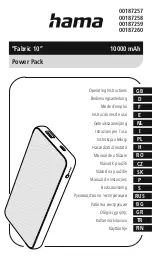
12
| English
Controlling temperature
You can control the temperature of the airflow using the
thumbwheel
(5)
.
The positions marked on the thumbwheel correspond to the
following temperature ranges:
Thumbwheel position
Temperature in °C
1
50–80
2
130–160
3
210–240
4
280–310
5
340–370
6
410–440
7
480–510
8
550–580
9
620–630
Thumbwheel position
1
is suitable for cooling down a heated
workpiece or for drying paint. It is also suitable for cooling
down the power tool before putting it down or changing the
attachment nozzles.
Practical advice
u
Pull the plug out of the socket before carrying out any
work on the power tool.
Note:
Do not position the nozzle
(3)
too close to the work-
piece that you are using the power tool on. The resulting
build-up of air can cause the power tool to overheat.
Removing the heat shield
When working in particularly tight spaces, you can remove
the heat shield
(4)
by turning it.
u
Caution: Nozzle is hot!
Working without the heat shield
increases the risk of burns.
Always switch the power tool off and allow it to cool before
removing or attaching the heat shield
(4)
.
To make the power tool cool down quicker, you can also let it
run briefly on its lowest temperature setting.
Setting down the power tool
Set the power tool down on the storage surfaces
(1)
to leave
it to cool down or to keep both hands free to work with.
u
Take particular care when working in the vicinity of
the power tool while it has been set aside.
The heat
from the nozzle or the air flow can cause burns.
Position the power tool on an even, stable surface. Ensure
that it cannot tip over. Secure the cable outside of your
working area so that it cannot pull the power tool down or
cause it to flip over.
Switch the power tool off when not in use for a long period
and pull the mains plug out of the socket.
Example applications (see figures A–G)
Images of example applications can be found on the graphics
pages.
The distance between the nozzle and the workpiece de-
pends on the material you are working on (metal, plastic
etc.) and the intended working method.
The optimum temperature for each application can be de-
termined by a practical test.
Always test the amount of air and temperature first. Start at
a greater distance and a lower power setting. Then adjust
the distance and power setting according to requirements.
If you are unsure what material you are working on or what
effect the hot air might have on it, first test the effect on a
concealed area.
All example applications apart from "Stripping paint from
window frames" can be carried out without the use of ac-
cessories. However, using the recommended accessories
will simplify the work and considerably increase the quality
of the result.
u
Take care when changing the nozzle. Do not touch the
nozzle while it is hot. Leave the power tool to cool
down before changing the nozzle, and wear protective
gloves when doing so.
The heat from the nozzle can
cause burns.
To make the power tool cool down quicker, you can also let it
run briefly on its lowest temperature setting.
Removing varnish/loosening adhesives(see figure A)
Fit the surface nozzle
(6)
(accessory). Briefly soften the var-
nish with hot air and remove it with a clean spatula. Long
heat exposure burns the varnish and makes removal more
difficult.
Many adhesives can be softened using heat. By heating ad-
hesives, you can break connections or remove excess adhes-
ive.
Stripping paint from window frames (see figure B)
u
The glass protection nozzle (7) (accessory) must be
used for this application.
There is a risk that the glass
may break.
You can remove the paint from profiled surfaces with a suit-
able spatula and brush it off with a soft wire brush.
Thawing frozen water pipes (see figure C)
u
Before applying heat to the pipe, check it is in fact a
water pipe.
Water pipes and gas pipes often look
identical from the outside. Gas pipes must under no cir-
cumstances be heated.
Fit the angle nozzle
(8)
(accessory). Gradually heat the
frozen points of the pipe, starting at the outlet and moving
back towards the inlet.
Take great care when warming plastic pipes and pipe con-
nections to avoid causing damage.
Shaping plastic pipes (see figure D)
Fit the reflector nozzle
(9)
(accessory). Fill plastic pipes with
sand and seal them on both sides to prevent the pipe bend-
ing. Carefully and evenly heat the pipe by moving the tool
back and forth from one side to the other.
1 609 92A 4UD | (15.03.2019)
Bosch Power Tools













































